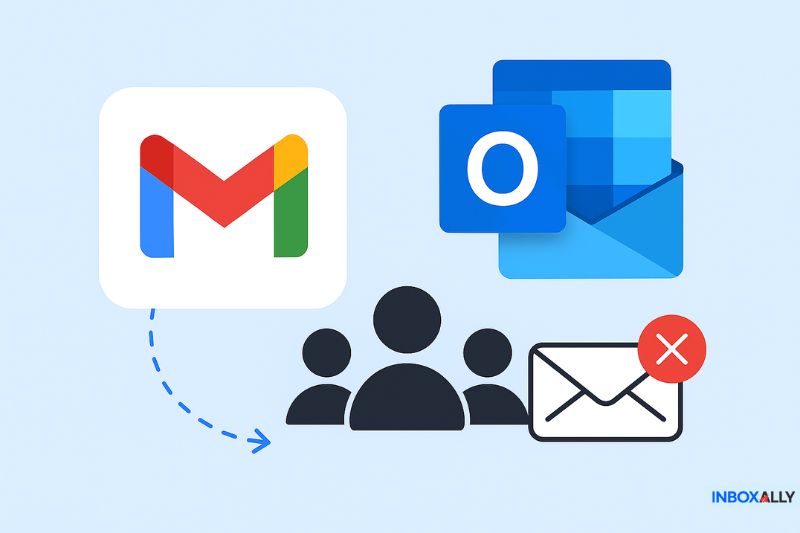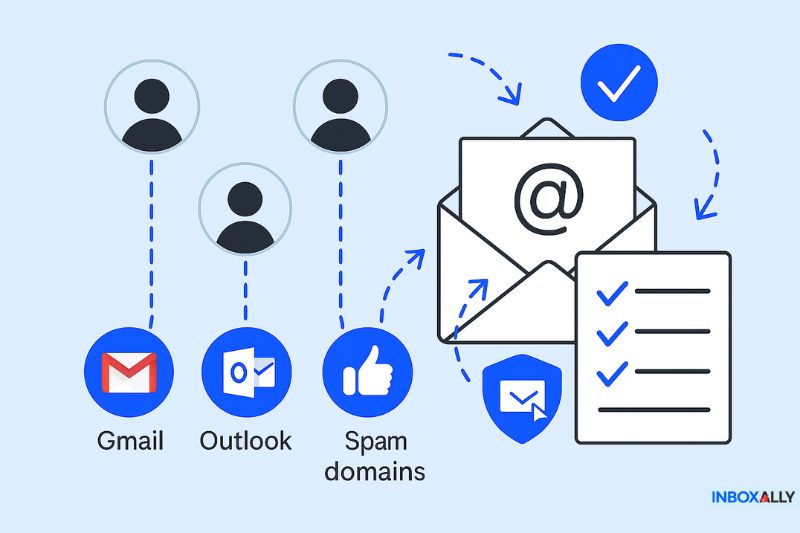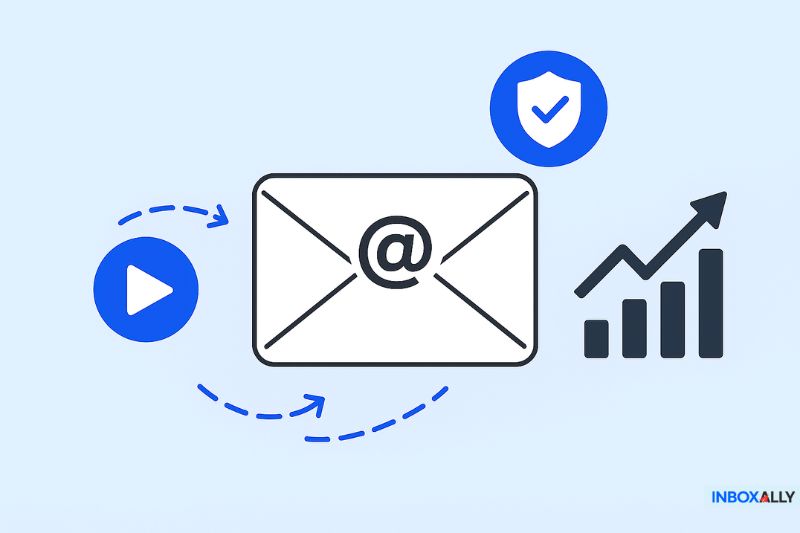GMass has officially shut down its email warm-up service, leaving many senders looking for a backup plan. If you’ve been relying on it to keep your cold emails out of spam, the risk just went up-way up.
Inbox placement has been a growing challenge in recent years, and without a proper warm-up tool, marketers are left with fewer options and more restrictions when it comes to mass email sending. So, does the end of Gmass warm-up mark the beginning of a long-predicted collapse of email marketing, or do we still have an honest shot at controlling our deliverability fate? Let’s find out.
Key Takeaways
- GMass shut down its warm-up service because of Gmail API rule changes.
- Warming up your email is key to keeping a good sender and domain’s reputation and landing in the inbox.
- GMass had some big flaws; it only worked with Gmail, used low-quality accounts, and lacked good diagnostics.
- InboxAlly works on multiple platforms, uses real-life people for engagement, and doesn’t rely on Gmail’s API.
- The best deliverability comes from using a good warm-up tool and following smart sending habits.
What’s behind the GMass shutdown
![]()
TL;DR: GMass’s warm-up feature was killed by a single policy change imposed by Google. The service relied on Gmail API access to run its warm-up process, but under this new policy, keeping warm-up running could’ve made GMass lose access to its API access altogether, and with it, the ability to run much of the product. Faced with that, they shut it down.
GMass isn’t alone in this. Any warm-up tool built on the same Gmail API bedrock is either shutting down or under the same pressure. That means the warm-up space is about to look very different, and those who don’t adapt will see it first in their open rates.
This is a reminder that your entire deliverability strategy can collapse if it depends on a single provider’s rules, which is why the next move is about upgrading to something more resilient that helps protect email reputation.
Why should you care?
There’s no shortage of “you need to warm up your mailing server” advice online, but 2025 could be the year everyone scrolls to page 10 of Google looking for better answers on how to do an email warmup right.
When you start sending campaigns from a new or dormant account, mailbox providers don’t know if you’re trustworthy. Warm-up builds that trust by generating consistent, positive engagement signals: opens, replies, and even taking emails out of spam.
Right now, skipping warm-up is playing with fire. Spam filters are smarter; algorithms now score senders based on engagement history, and only a deliberate, well-run warm-up process can make sure cold emails land.
This makes it obvious why inbox placement is everything for ROI. If your message doesn’t reach your audience, no amount of segmenting or automated follow-ups will help pay off the rising cost of running those cold email campaigns.
GMass limitations before the shutdown
Even before it shut down, the Gmass email warmup system had problems. It only worked with Gmail, leaving out Outlook and Microsoft 365. For B2B senders, that’s a big gap, as a lot of business email still runs on Microsoft, and ignoring it means your warm-up signals wouldn’t really match the inbox variety you’d see in real campaigns.
The engagement network wasn’t great, either. Since GMass was free or cheap if you were on a paid plan, it used a lot of low-quality or burner email accounts. These could never act like real, active users, and mailbox providers can tell the difference.
With no proper diagnostics, GMass also didn’t warn you about blacklist issues, spam-trigger words, or DNS setup problems. Without that info, you were basically flying blind and only noticed deliverability issues once your results dropped.
If there’s one takeaway, it’s that replacing GMass with “just another Gmail API warm-up clone” is a short-term solution at best, and likely a repeat of the same weaknesses.
What can we learn from this?
Instead of panicking over GMass shutting down, maybe we should see it as a chance to rethink how we handle email deliverability. A quick replacement won’t cut it. But what if we could step up to a system that builds and protects our sender reputation over the long run?
Template-based warm-up emails sent to a pool of bots or inactive accounts are dead. What we need now is ongoing, human-like engagement: real opens, real replies, real clicks—the kinds of signals that mailbox providers know they can trust
With more complicated rules and constantly changing algorithms, your email warmup tool should:
- Adjust to policy changes as they happen
- Work with Gmail, Outlook, and custom domains
- Sustain a good sender reputation while campaigns are live
That will let you future-proof your outreach and keep your cold emails in the primary inbox.
How is InboxAlly any different
Most warm-up tools handle email warm-up by sending automated messages between accounts, hoping mailbox providers see it as engagement. But InboxAlly takes a completely different approach—one that isn’t dependent on the Gmail API, so it’s unaffected by the shutdowns that took out GMass and others.
It works with Gmail, Outlook, and custom domains, so your warm-up targets the inboxes you’ll be sending to. This also means that InboxAlly uses real people, instead of fake accounts or bots. Every open, reply, click, and spam rescue is done on purpose to show email providers your emails are wanted.
Unlike others, InboxAlly can fine-tune inbox placement during your actual campaigns, not just in a pre-launch warm-up phase, and your cold emails, newsletters, and follow-ups all benefit from ongoing deliverability improvement. It monitors blacklists, sender reputation, and gives custom tips based on your sending patterns.
All of these methods combined will keep your emails out of the spam folder as long as you get the campaign side right.
If you want a stable, proven solution that works in today’s tightening and often confusing email environment, InboxAlly’s email warmup tool is what will protect your sender reputation.
Warm-up alternatives you should know about
Now that GMass is gone, a few other warmup services could be worth a look:
- MailFlow, which has a basic warm-up automation for Gmail accounts and Outlook, is often used by small businesses and freelancers.
- Warmup Inbox is an affordable option that uses verified accounts, but its limited analytics make it hard to see deeper deliverability problems.
- Warmy.io for high-volume sending and anyone who needs multiple languages. It’s pricey, though, and doesn’t have as detailed diagnostics as many B2B senders need.
These tools are known for a reason, and there’s no denying they can do great in a lot of ways, but they mostly focus on the warm-up stage. Once your campaigns start, it’s entirely up to you to manage multiple accounts, track sends with a Google Sheet, and route opens and clicks through a custom tracking domain for better data. InboxAlly keeps improving deliverability while you’re sending, combines warm-up with engagement, and gives you data-driven advice to keep your sender reputation above the competition. In a space full of one-trick tools, it’s time to start looking at the bigger picture.
The show must go on
GMass’s warm-up shutdown isn’t the end of your cold outreach—far from it. Reliable warm-up solutions are still out there if you know where to look and are willing to adapt to a landscape that’s always changing.
So don’t panic! Your campaigns can keep moving, and if mailbox stress is taking its toll, you can hand some of that burden to a tool that builds and protects your sender reputation no matter what. Book a free demo with InboxAlly and keep your attention on growth!


